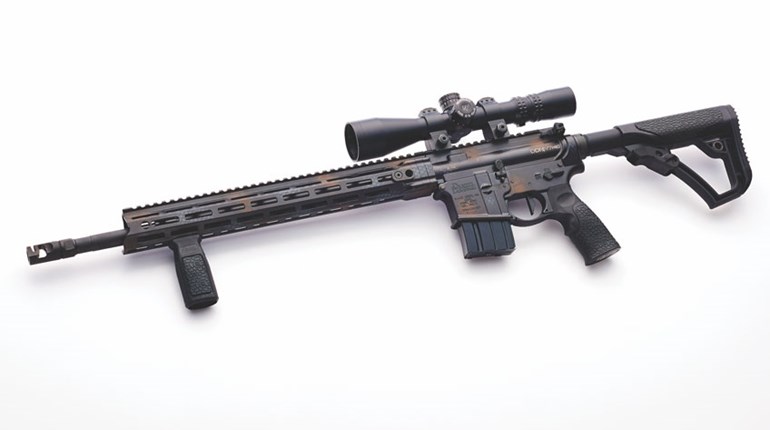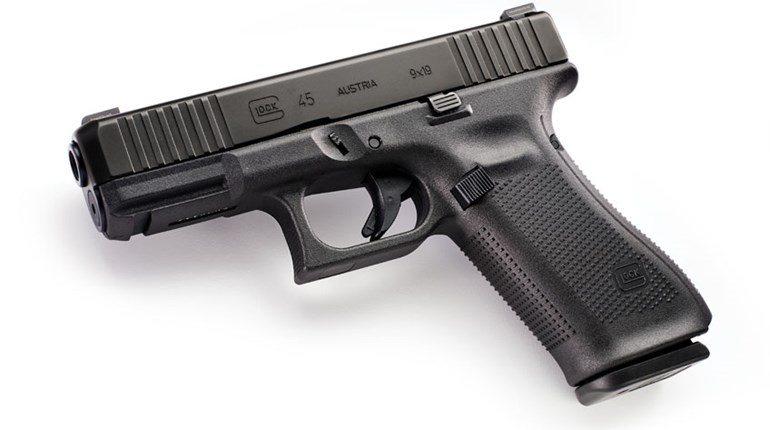
When it comes to Carry Life footwork, it doesn’t get much easier: Never go backwards, and keep those toes pointed in the direction you’re moving.
Now Carry on.
OK, OK, OK: It’s not quite that easy, but maybe we made our point—it’s nearly so. It’s in reintroducing the hands and firearm that things get tricky.
We’ve made many references to “getting off the ‘X’” as the first thing that needs to happen if an aggressor confronts you. It may seem odd that getting to your wherewithal isn’t the first priority, but we stick by our assertion. Making it clear that you’re paying attention and exiting decisively is the best way to short-circuit confrontation altogether, and is always preferred. It may seem odd that getting to your wherewithal isn’t the first priority, but we stick by our assertion.
Deciding how such a departure ought to occur, however, isn’t as simple as you might think. Anti-Second Amendment lunkheads have a uniform view: Run like hell. We don’t necessarily disagree. The trouble starts with the assumptions that underpin their insistence on such an action ad infinitum—that successful flight is even possible, and that no other options should be maintained if it fails—in that case, the lunkheads suggest complete submission (“active compliance”), but the track record here is very spotty. Recollect that the other name for this is appeasement, and it is chancy on any scale.
So if you must act—Cooper Orange (or Red) in other words—are there “mechanics” for doing so? The answer is an emphatic, “You bet.”
Remember your first job is not to draw/unmask your firearm, to say nothing of shooting. Rather, the goal is to make the aggressor change his plan to his disadvantage. If you’re paying enough attention, this can happen early, and in a way that gets inside their OODA loop. If their positional or situational edge disappears, a lot of evidence shows that potential assailant(s) will break off. You’ve also dramatically increased the likelihood that flight will end the situation—if you keep your cool and use the correct footwork.
That word “correct” is sort of a big deal here: We’re no friends of dogma, and there’s a lot of it in our business—opinions asserted as “right” when they clearly can’t apply to or be accomplished by everyone, or in all circumstances. But barring severe physical differences (that is, relatively rare variations), this isn’t one of those cases: The first rule, getting off the “X,” is never back-up.
“Why” is actually elementary. It also has nothing to do with unwarranted estimations of courage or cowardice. Instead, it’s the mechanics of how the foot operates combined with our front-of-the-head vision. They unhelpfully conspire to make falling over backward very likely, a danger that grows as we try to move faster. Worse yet, the sort of injury that occurs if you do go down—a substantial blow to the back of the head—may not just be momentarily disastrous. Lifelong consequences can proceed from such an injury and get worse as we age—we’ve seen it happen. Major “yuck.”
The key is to move in a direction of safety with your feet working the way they were designed to: toes pointed directly (or nearly so) along your line of advance. That’s “safety” in the best sense—an “exit.” In practical terms, however, it may mean settling for putting an object between you and the aggressor(s). At the least, move in a direction that adds time and options, rather than limiting them.
Where complications enter is with the need to keep that aggressor in view at the same time. Getting off the “X” is of little value if your second action is the need to present your firearm, but you can’t see enough to wisely and legally make this decision. This is where the anti-self-defense folks run aground: The presumption that you can simply show your tail feathers at speed violates this rule and may well increase your peril. No imagination whatsoever is required to see why this is true: You’ve ceded important psychological ground and opened yourself up to being chased toward a waiting confederate. On a simpler level, we should all remember from childhood the hazards of the chased—looking both ahead and behind is fraught with challenges.
Forward movement, even obliquely, is also a problem. It’s the best for engaging if you must, but runs the risk of turning you into the aggressor in the eyes of third parties—potential witnesses who don’t understand the situation. It can lead to the old “who did what first” problem.
Movement directly to right or left invokes the problem of cross-footing. Not nearly as serious as backing up, it still presents many issues. These compound as you try to go faster. Actually engaging gets more complex too, especially if you use a locked elbows/extended arms technique. For righties moving left or lefties moving right, it’s very difficult to bring your firearm to bear. In either direction, locked/extended and the “hard” across-the-body arm attitude will make your firearm bounce. Misses become a potentially huge hazard.
If you haven’t exactly been keeping score, this limits your “tactical withdrawal” to rearward-left, and rearward-right. And we have good news here: There are two techniques that can work without compromising the keep-the-toes-along-the-line-of-advance rule.
The first we discussed here—Paul Castle’s Center Axis Relock or CAR technique. With practice, you can acquire both precision and speed with his method, yet it keeps those toes in the proper direction. For righties, this is most natural moving to the right and rearward, and the opposite for lefties (leftward/rearward). “Skinning” the pistol from one side to the other takes care of the other direction, but remember to break these techniques in with dry fire/inert/blue gun practice first. Be especially cautious about sweeping the “off” hand as the two join.
The disadvantage of CAR is that it’s built around both hands being on the gun. If you’re with someone, or in an environment with impediments (other people, doors, etc.), CAR may not be practical. You may also need one hand to be guiding/pushing a loved one to safety in front of you, or that leading hand may be needed for navigation/manipulation.
In these situations, all that strong hand/weak hand practice is about to pay off. Hopefully, no crickets are chirping at this point: You have been practicing both, correct? In what we call “trailing arm” (no doubt it has another name, we just can’t nail down what it is), the pistol is now “trailing” behind you toward the threat in either the strong or weak hand, depending on movement direction. Righties move right and to the rear by skinning the pistol to the left hand, lefties to the right hand for movement to the left. While it’s tougher shooting, this will help. Remember that locking the elbow is unhelpful, as for most people it exacerbates the “bounce” of the pistol at the end of an outstretched arm. Get away first if you can. Engage as a last resort.
Note that these two techniques can be usefully combined. Leftward/rearward keeps the pistol in the right hand in trailing arm, and CAR keeps it there for rightward/rearward. The same is true for lefties in reverse. Crucially, this makes skinning left-to-right or right-to-left unnecessary, as long as the second hand is not needed for “nav” purposes. Your strong hand can stay your strong hand.
Like any technique change, it’s crucial to practice these first without a “hot” gun. Once the toes/feet are under control, especially mind the footing on your practice surface—these are not “beginner” fare and due caution is your responsibility. All the normal safety considerations apply as well, and a safe backstop in particular must be in play as your angle of engagement changes.
Finally, remember that you’re moving away from your target. Don’t let this gull you into taking shots at indefensible distances should the unwanted circumstance ever arise. Get away first if you can. Engage as a last resort.
Now step, and Carry on.
































